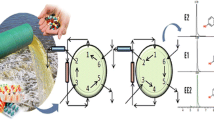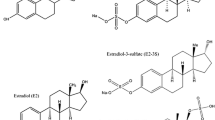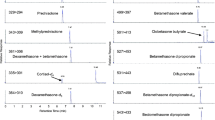Abstract
A comprehensive method was developed for the simultaneous trace analysis of ten hormone antagonist pharmaceuticals (raloxifene, exemestane, letrozole, anastrozole, mifepristone, finastride, tamoxifen, N-desmethyltamoxifen, clomiphene, and toremifene) in municipal sewage and hospital wastewater samples. The target compounds were firstly extracted using an Oasis HLB cartridge, followed by purification by an aminopropyl cartridge, and were then analyzed by liquid chromatography electrospray ionization tandem mass spectrometry in positive ion mode. The recoveries for the analytes based on internal standard calibration in different test matrices ranged from 67.6 to 118.6% (with the exception of mifepristone in clinical wastewater samples), with relative standard deviations less than 20%. The method quantification limits of the ten pharmaceuticals were in the range 0.10–2.0 ng/L. Excluding exemestane and N-desmethyltamoxifen, eight drugs were detected at 0.20–195.0 ng/L in hospital wastewater and municipal wastewater samples from Beijing.

Analysis of hormone antagonists in clinical and municipal wastewater by liquid chromatography tandem mass spectrometry

Similar content being viewed by others
References
Group Early Breast Cancer Trialists’ Collaborative (1992) Lancet 339:1–15
Fisher B, Constantino JP, Wickerham DL, Redmond CK, Kavanah M, Cronin WM, Vogel V, Robidoux A, Dimitrov N, Atkins J, Daly M, Wieand S, Tan-Chiu E, Ford L, Wolmark N (1998) J Natl Cancer Inst 90:1371–1388
Mellon JK (2005) Eur J Cancer 41:2016–2022
Narvekar N, Critchley HOD, Cheng L, Baird DT (2006) Hum Reprod 21:2312–2318
van Leeuwen FE, Benraadt J, Coebergh JW, Kiemeney LA, Gimbrere CH, Otter R, Schouten LJ, Damhuis RA, Bontenbal M, Diepenhorst FW, van den Belt-Dusebout AW, van Tinteren H (1994) Lancet 343:448–452
Albert C, Gilles K, Herbert SR (1996) Mutat Res 349:85–94
Rossing MA, Daling JR, Weiss NS, Self SG (1994) N Engl J Med 331:771–776
White INH (2001) Toxicol Lett 120:21–29
O’Regan RM, Cisneros A, England GM, MacGregor JI, Muenzner HD, Assikis VJ, Bilimoria MM, Piette M, Dragan YP, Pitot HC, Chatterton R, Jordan VC (1998) J Natl Cancer Inst 90:1552–1558
León A, Teh SJ, Hall LC, Teh FC (2007) Aquat Toxicol 82:195–203
Roberts PH, Thomas KV (2006) Sci Total Environ 356:143–153
Tauxe-Wuersch A, De Alencastro LF, Grandjean D, Tarradellas J (2006) Int J Environ Anal Chem 86:473–485
Li GL, Liu XC, Lin HR (2005) Acta Physiol Sin 57:473–479 (in Chinese with English abstract)
Fent K, Weston AA, Caminada D (2006) Aquat Toxicol 76:152–159
Sun LW, Zha JM, Wang ZJ (2009) Aquat Toxicol 93:83–89
Sun LW, Zha JM, Spear PA, Wang ZJ (2007) Environ Toxicol Pharmacol 24:23–29
Sun LW, Zha JM, Spear PA, Wang ZJ (2007) Comp Biochem Physiol C 145:533–541
Zhang ZL, Zhou JL (2008) J Chromatogr A 1154:205–213
Thomas KV (2004) Hilton MJ. Mar Pollut Bull 49:435–444
Hilton MJ, Thomas KV (2003) J Chromatogr A 1015:121–141
Liu R, Zhou JL, Wilding A (2004) J Chromatogr A 1022:179–189
Wang S, Huang W, Fang GZ, Zhang Y, Qiao H (2008) Int J Environ Anal Chem 88:1–25
Chang H, Wu SM, Hu JY, Asami M, Kunikane S (2008) J Chromatogr A 1195:44–51
Farre M, Kuster M, Brix R, Rubio F, de Alda MJL, Barceló D (2007) J Chromatogr A 1160:166–175
Vulliet E, Wiest L, Baudot R, Grenier-Loustalot MFG (2008) J Chromatogr A 1210:84–91
Richardson SD (2007) Anal Chem 79:4295–4324
Richardson SD (2009) Anal Chem 81:4645–4677
Matuszewski BK, Constanzer ML, Chavez-Eng CM (2003) Anal Chem 75:3019–3030
Taylor PJ (2005) Clin Biochem 38:328–334
Acknowledgement
The authors gratefully acknowledge financial support from National Natural Science Foundation of China (20837003 and 20607004).
Author information
Authors and Affiliations
Corresponding author
Electronic supplementary materials
Below is the link to the electronic supplementary material.
ESM 1
(PDF 561 kb)
Rights and permissions
About this article
Cite this article
Liu, X., Zhang, J., Yin, J. et al. Analysis of hormone antagonists in clinical and municipal wastewater by isotopic dilution liquid chromatography tandem mass spectrometry. Anal Bioanal Chem 396, 2977–2985 (2010). https://doi.org/10.1007/s00216-010-3531-0
Received:
Revised:
Accepted:
Published:
Issue Date:
DOI: https://doi.org/10.1007/s00216-010-3531-0




